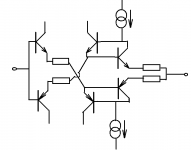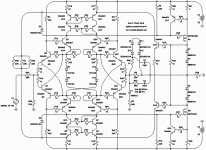From my thread
http://www.diyaudio.com/forums/showthread.php?s=&threadid=118476
you can add my favourite complementary input stage to your consideration list:
http://www.diyaudio.com/forums/showthread.php?s=&threadid=118476
you can add my favourite complementary input stage to your consideration list:
Attachments
darkfenriz said:From my thread
http://www.diyaudio.com/forums/showthread.php?s=&threadid=118476
you can add my favourite complementary input stage to your consideration list:
thanks, darkfenriz
I have most often enjoyed you contributions.
At least you often post something useful, something possible to further explore, to build upon.
And not of a lot of verbal mumbo jumbo hypothesisism, out in space or out of concern for real audio & music perception.
Seems some post just to impress us.
Not in order to be of assistance and give some useful advice to 99% of diy audio members.
thanks again, for your schematic example in attachment.
/Lineup
PMA said:No no.
Complementary differential symmetry is really the best.
john curl said:You people worry too much about superficial things.
First of all, the advantage of complementary differential is that it creates two separate signals that are opposed in DC voltage from each other. This gives 2 times the gain, without any phase delay increase.
====
I have never modeled this, but I will, sooner or later.
I tend to agree with you here, John.
( which is not always my case
they worry to much
And we can not often say:
This is best!
and
This is no good!
... unless we refer to a specific situation, specific conditions.
A good audio designer, will look for: what is best way to achieve what I want to achieve.
To automatically rule out This or That possibilty, topology or Device, from the start
.... can (and I say will sooner or later) reduce your chances to achieve your goal.
This is the one fear of narrow minds, as well as of intolerant people:
The Limitation of Creativity, Imagination and getting New Views & Unique Ideas.
thanks for reading this post
by
lineup
lineup said:
I tend to agree with you here, John.
( which is not always my case)
they worry to much
And we can not often say:
This is best!
and
This is no good!
... unless we refer to a specific situation, specific conditions.
A good audio designer, will look for: what is best way to achieve what I want to achieve.
To automatically rule out This or That possibilty, topology or Device, from the start
.... can (and I say will sooner or later) reduce your chances to achieve your goal.
This is the one fear of narrow minds, as well as of intolerant people:
The Limitation of Creativity, Imagination and getting New Views & Unique Ideas.
thanks for reading this post
by
lineup
You make some good points here. Every topology has its plusses and minuses. The full complementary has many nice features, but unfortunately it requires complementary JFET input pairs that are hard to find. As far as issues brought up about amount of current that can be produced or any effects of phase shift, these are things that can be readily evaluated by simulation, and my experience has been that the proper use of a unipolar input design can virtually always do as well as a full complementary design.
It is certainly true that if the JFET LTP is run at the same tail current and the same device is used for the N-channel device, all else remaining equal, the full complementary approach will often be quieter. However, I believe that any power amp that can do 5 nV/rt Hz or better in input-referred noise is fine. Others may disagree with this.
Cheers,
Bob
Hi LineSource
Interesting that this thread should reach this point ...
A question I have is ... can an Input Stage be made to produce sufficient Gain , Current/Voltage drive and a low output impedance to remove the need for a VAS?
I think yes, but I'm studying this matter just now for a new project that I have in mind (a sort of power buffer).
There'll probably be need of pre-drivers (triple or quad OPS). But having one stage less is worth the trouble IMO.
The marked term I have never heard before. And "Google" says "no results found".hai friends please help me for 5.1 remote circuit and programing code
From my thread
Old school, novel circuit amp - diyAudio
you can add my favourite complementary input stage to your consideration list:
Was messing with near same idea, some time ago.
Don't got matching P depletion device? Fake it...
Once had a less cluttered minimalistic drawing, but
I've long since lost track of where I mighta stashed it.
Bout half these parts easily Muntz'd without seriously
degrading the performance.
Since both fake P and fake N contain both flavors of
emitter drop in series, they should naturally match.
This one relies upon VBE at near constant current,
and doesn't care too much about Beta. So matching
should be easy. Was my theory of the day anyways...
Attachments
Last edited:
- Status
- This old topic is closed. If you want to reopen this topic, contact a moderator using the "Report Post" button.
- Home
- Amplifiers
- Solid State
- Unipolar vs complementary input stage

